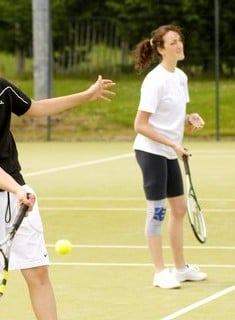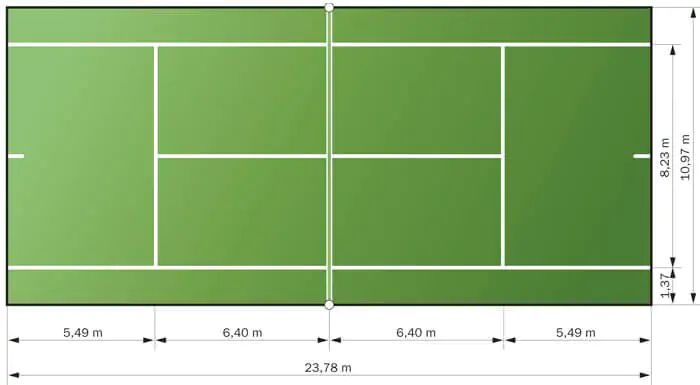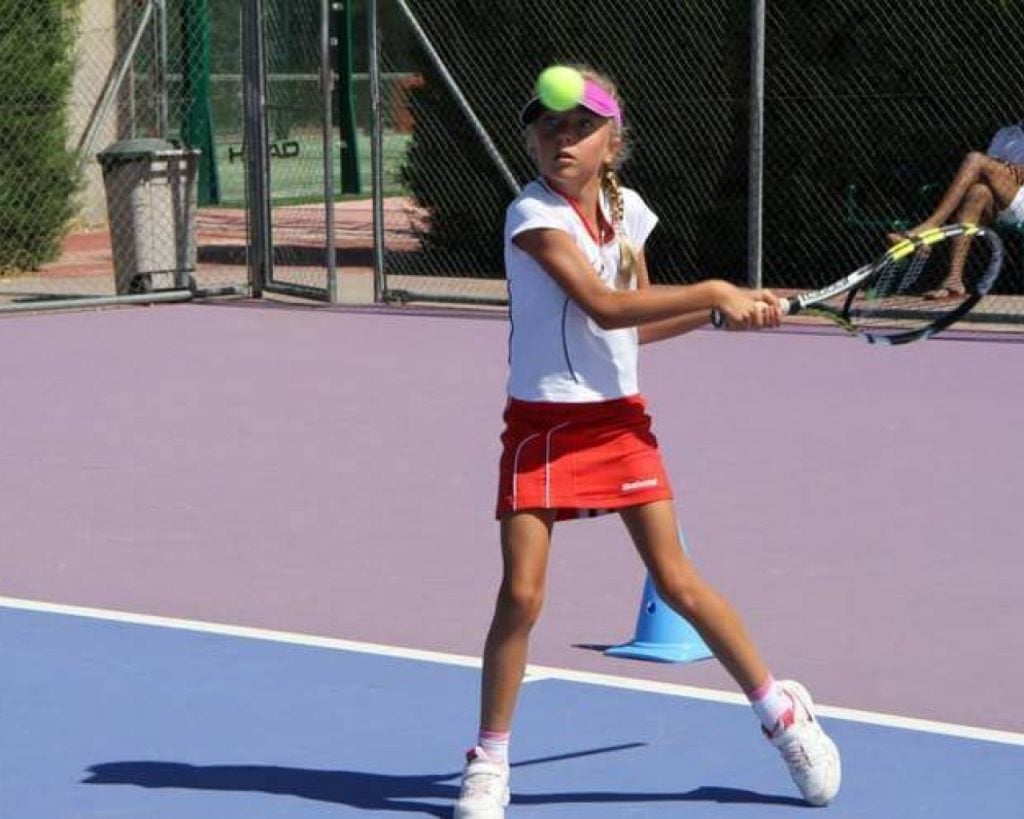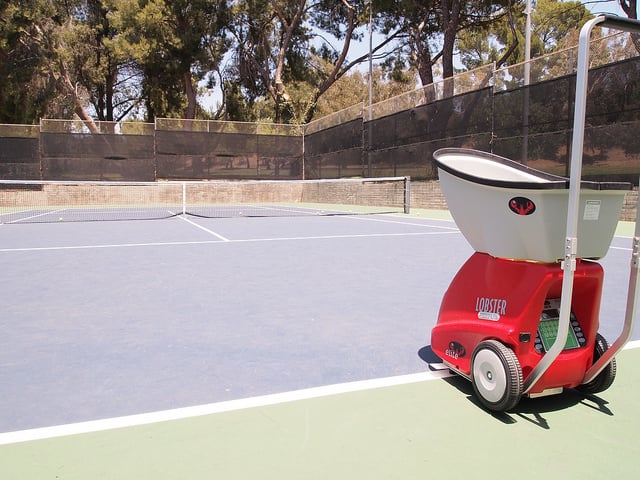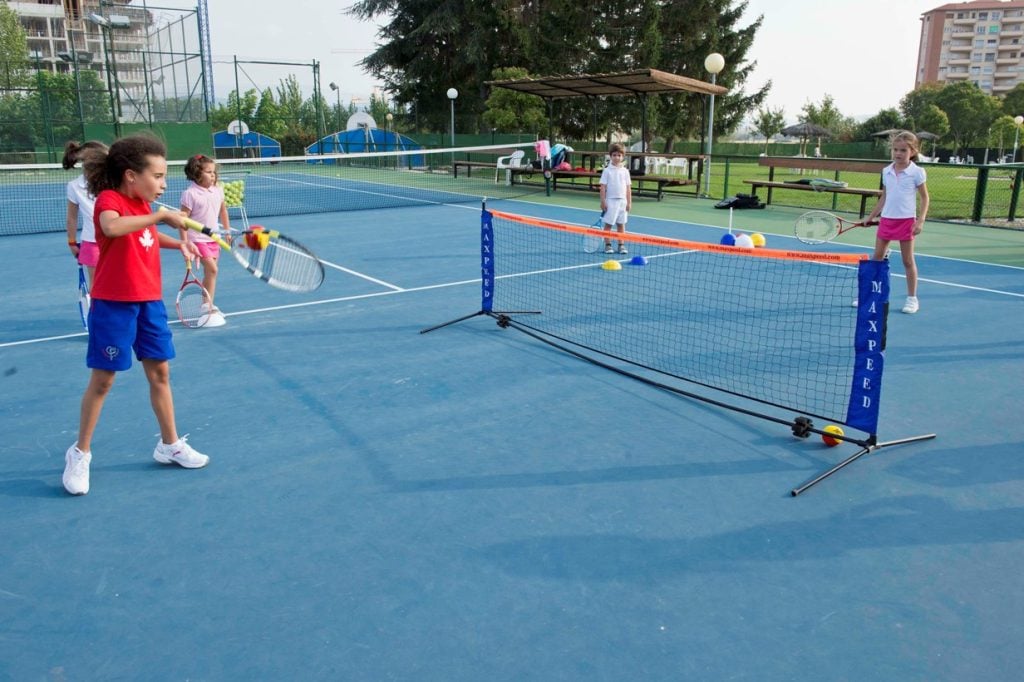To be an excellent player, the first thing you need to know is the arsenal of tennis strokes you have to execute and when to choose them in order to make the best decision in a play.
Tennis is a very special and complicated sport, because it is not enough just to know how to execute the strokes perfectly, you must also know when to do them depending on the surface, the weaknesses of the opponent and your own virtues.
But don’t worry, at Ertheo we offer tennis summer camps adapted to all levels: Beginner, Intermediate and Advanced, to clarify all these concepts.
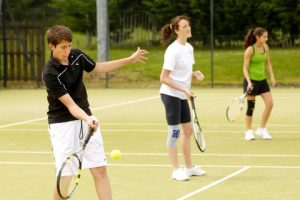
And don’t despair, as in any sport, practice makes perfect and it is logical that some strokes seem easier than others at the beginning.
The key is to keep practising with great consistency and, session by session, you will see a noticeable improvement in your game.
Here are the main tennis strokes you need to learn to take your playing skills to the next level:
Stand-by position
Before any stroke, the first thing you must master perfectly is the stand-by position.
The stand-by position is the starting stance for any opponent’s stroke, which will allow you to move quickly in any direction so that you can respond with your stroke correctly.
Similar to other sports such as basketball or baseball, this position consists of keeping your back straight while leaning slightly forward at the hips and bending your knees.
The weight of your body should be on the balls of your feet, this will help you to start your movement.
The most important part of the stance is learning how to get out of it as quickly as possible, so practice it to get used to keeping your knees bent and gaining enough stamina in your legs to keep you active throughout the game.
Once you are very clear on the concept of the stance, it’s time to start practicing your tennis strokes.
Forehand or drive
Mastering the forehand or drive is fundamental to being imposing on a tennis court and, fortunately, it is the easiest to learn and practice over time.
To hit a good forehand, what you need to do is wait for the ball after the bounce as you profile to hit it on the side of your skilful arm.
The stroke itself is a slightly downward motion that should serve to lift the ball up and over the net with power, direction and some spin if the situation warrants it.
Tennis strokes must take everything into account
The feet are also important in order to get the necessary power into the stroke.
Your support will be on your weak leg, while your strong leg will support the movement of your arm to give power to the stroke.
At the end of the stroke, your weak foot will serve as support and your strong foot will be on the toe, following the inertia of the arm, shoulder and torso movement.
When to use a forehand
The ideal height to hit the forehand ball is at chest height, that is where you will be able to hit the most powerful shot.
However, depending on the height also varies the amount of spin and power the shot should have.
For example, the higher the ball is, the more power you can put into your shot, especially if you are a player over 6 feet tall.
However, if the ball comes at hip height, the best thing to do is to add topspin to give it more depth and better placement.
Also, depending on the surface, topspin can be key to surprise your opponent and make his or her shots more uncomfortable.
On hard court or grass, the drive is unquestionably the easiest way to find a winning shot; but on clay it can be used more as an approach and to change the pace with spin and speed, as the ball does not run as fast on this surface.
By the way, an approach shot is a shot that gives you a certain advantage and allows you to go up to the net to finish an attack, taking the initiative.
We leave you with this video with more tips on how to hit an effective forehand/drive shot:
Backhand
The opposite of the drive, the backhand is another of the fundamental strokes to become a great tennis player, although it is also difficult to master.
There are two ways of hitting the backhand: one-handed or two-handed, but coaches are nowadays favouring the two-handed stroke.
Two-handed backhand allows novice players to learn the stroke faster and have more precision and power; although it is a decision that is definitely taken after several sessions, depending on the player’s sensations.
Contrary to the forehand, to execute the backhand you must profile your body towards your weak side and wait for the ball to bounce in order to hit it when it is in front of your position.
Footwork is essential to give power and accuracy to the backhand; you must rely on your strong leg and give fluidity to the movement with your less skilled leg.
The key to a good backhand is to coordinate all your movements, from the grip, feet, torso and swing; everything must be transformed into a single natural and fluid movement to manage it.
You have to have a lot of patience, the backhand is the most difficult stroke to master in tennis and requires a lot of advice to make it more effective.
That’s why at Ertheo we offer you lessons adapted to your level and precise follow-up to give you personalized advice and take your game to the highest level step by step.
How to use the backhand depending on the surface, the opponent and more
The backhand can be a real headache for the player who does not master it, so if you see that your opponent does not hit well in this way, make your shots always force him to use the backhand; this will make him more imprecise and allow you to take the initiative.
On clay, the backhand is the door to an endless number of moves, as you can use it to trick your opponent into making drop shots that make him run or use the slice to confuse your opponent with its effect; although these are more advanced strokes.
On hard courts and grass, the backhand parallel shot is a lethal weapon if you can master it, as you can use it as an unexpected weapon in tight situations.
Another frequent use of the backhand is to give width to the court and move the opponent from side to side, taking advantage of the angles of each shot to wear him down physically.
The backhand can be flat, topspin or slice, and these are mechanics that must be practiced session by session in order to improve them.
Serve or service
The serve is the cornerstone of any offensive game of a tennis player, as it allows you to have a much higher percentage of points won with your serve.
Holding your serve and making it very difficult to get a break will make you a solid and fearsome player, so it is a shot that you must practice a lot.
The serve is a whole movement that must be done with fluidity coordinating all parts of your body and that this works as a kind of oiled gear at the time of execution.
To begin, you must stand behind the baseline, placing your less skilled foot diagonally in front of the court and your skilled foot parallel to the baseline.
Then, grip the racket by following the handle to the end of the grip and rest the hand holding the ball on the other side of the racket to start the movement.
Swing your body forward and then backward, then separate your arms and bring them up in a coordinated manner. The front arm will throw the ball and the back arm will hit the racket at the right moment.
When the ball is at your highest point of reach, bend your knees and make a forward motion to impact the ball.
The serve can be flat, slice or topspin; we’ll show you how to execute each one in a video below.
The importance of the serve on surfaces
There are professional tennis players, such as Ivo Karlovic, who have built their entire game around their serve because of its power and effectiveness.
So if you manage to have a very good serve you will have an advantage that will drive your opponents crazy and make them work hard mentally.
The strategy of the serve game is to do what your opponent least expects, it is about analyzing their weakest point and exploiting it.
But also play with their weaknesses to confuse them and make sure that your serve always gives you an advantage or preferably an ace.
For the first serve, you should always use a powerful serve that throws the opponent off balance and makes it difficult for him to return.
While the second serve should be a safer shot, with more spin and directed to an area that the opponent does not expect, so that he cannot make a return that puts you in trouble.
Here is the video on how to serve in tennis:
Volley
The volley is the shot par excellence that tennis players must use to play close to the net, as it is executed without letting the ball hit the net.
To execute a volley you must place your opposite foot in front of the side where the ball is going to hit, from top to bottom in most situations.
The secret of volleys is to use the speed with which the ball is coming to your advantage, so you can hit the ball to one side of the court.
Volleys can be hit either forehand or backhand, so you should practice this shot a lot on both sides of the court.
When to use a volley
Remember that volleys are usually the lock for your offense and are executed after hitting an approach that allows you to get an advantage to the net.
Practice your volleys a lot to make your attacks much more effective, this was one of the many keys that allowed Roger Federer to enter the Olympus of tennis, as they are very effective on all surfaces.
And above all, if you are a good server and have a good stature, never neglect your volleys, they will be your direct flight to victory.
Smash
The smash is that powerful shot that is hit over the player’s head and serves to finish off a point after a very high and weak return from the opposing player.
A smash is always intended to become a winning point, as it is performed when we have a very advantageous position with respect to the opponent, either near the net or at least halfway down the court.
The key to doing a smash correctly is that the elbow of the racquet arm bends behind the back to get the necessary momentum for the movement.
Of course, this must also be accompanied by a waiting motion, knee bend and forward motion to direct the ball accurately.
When to use a smash
Of the tennis strokes, the smash should be the most effective, so it should only be used to finish a point in your favour.
The ball should come slow enough and over the player’s head, so that the whole movement can be done correctly.
Also, depending on the height of the ball, and especially on hard courts, you can let the return bounce in order to calculate the ball better after the bounce and hit the shot more calmly.
In the same way, on hard court the backhand can be strongly directed towards the court, as the ball will bounce and it will be very difficult for the opponent to connect.
However, on clay and grass it is better to direct your shot with depth to the opposite side of the court where your opponent is.
As a tip, it is also important to deceive your opponent with the direction your shot will take, especially if he/she is good at defending.
Dropshot
The dropshot is another of those tennis strokes that can make the difference in a very close match, as it opens up new possibilities for play.
The dropshot is a tennis stroke that consists of hitting the ball softly and leaving it as far away from the opponent as possible.
What you are looking for with a dropshot is that the opponent cannot reach the ball before its second bounce or, if he does, he does it with a shot that is too demanding and gives you an advantage.
When to drop shot
However, the key to the dropshot is to do it at a time when the opponent is not expecting it, so as to require him to run quickly from the back of the court to the net.
The best time to execute a dropshot is when the opponent is behind the baseline waiting for a powerful shot.
Top pros ‘hide’ the drop shot until the last moment with movements that simulate a strong backhand, but ultimately hit the ball smoothly and with spin.
This shot is effective on all surfaces, but it is most often used on clay, as the ball bounces less strongly on clay courts and it is more difficult to dislodge.
It is also a very effective tennis stroke against slow, very tall and veteran players, as counter-punching it requires a great expenditure of energy.
However, if you make a missed drop shot, you will most likely leave a winner for your opponent, as they will have a comfortable shot close to the net.
Practice the dropshot a lot and gradually add it to your arsenal of tennis strokes and increase the frequency with which you use it, only then will you be able to master it.
And the backswing
From the drop shot also comes its most effective response, the backswing.
This is a shot that the player must hit while running and very close to the net in order to respond to the drop shot in the best possible way.
It consists of hitting a soft shot from very close to the net and the ground, trying to get the ball as close to the opponent’s side of the net as possible.
In this way, you can cause the same effect that your opponent was looking for with the drop shot, getting close to the net and leaving you out of position.
If you have made a good counterpunch and to the opposite side of the net from where your opponent is going, you will probably put the situation in your favour.
Here is a video to show you how to make a drop shot/dropshot:
Lob
We close this post of tennis strokes with the lob, a stroke that can completely change the development of a point in your favour.
As long as you get it right, of course.
The lob shot must be very precise, as it consists of passing the ball over the opposing player, forcing him to retreat or directly winning the point.
To execute it, either on the forehand or backhand side, what you must do is to hit the ball from the bottom upwards so that it has a pronounced upward arc and is unreachable for the opponent.
When to lob
The lob can be a very important resource to respond to a shot that the opponent considers an approach.
If you see that the opponent starts to move forward towards the net after hitting his shot looking for a volley, you can surprise him with a lob.
The lob should be thrown with the intention of landing as close to the baseline as possible, inside the court of course.
This way, your opponent will be forced to step back and hit a very uncomfortable shot, without having a full view of the court.
You can use this advantage to get up to the net and finish off the point with a volley, as long as you have made the opponent sufficiently uncomfortable.
Lobs are equally effective on all surfaces and always have the same objective, to surprise and change the configuration of the play for the opponent.
And as with the drop shot, if you fall short you are probably giving your opponent a winning shot, leaving him a perfect ball to finish off.
How to choose the best tennis racket for you?
Undoubtedly, another key aspect to develop in tennis is to know which racket to choose to start playing.
To do this, you need to know that each racket has certain specifications that modify the power of your tennis strokes, the sweet spot, your balance, balance and more.
This is why racquets should always be chosen keeping in mind the level of the player who will use it, whether he/she is a beginner, intermediate or expert.
Having the racquet ready to start and very clear about the purpose of the tennis strokes, you are now perfectly ready to begin.
So don’t forget, he who perseveres, achieves; and in tennis you will need to repeat that a lot if you want to be a better player day after day.

